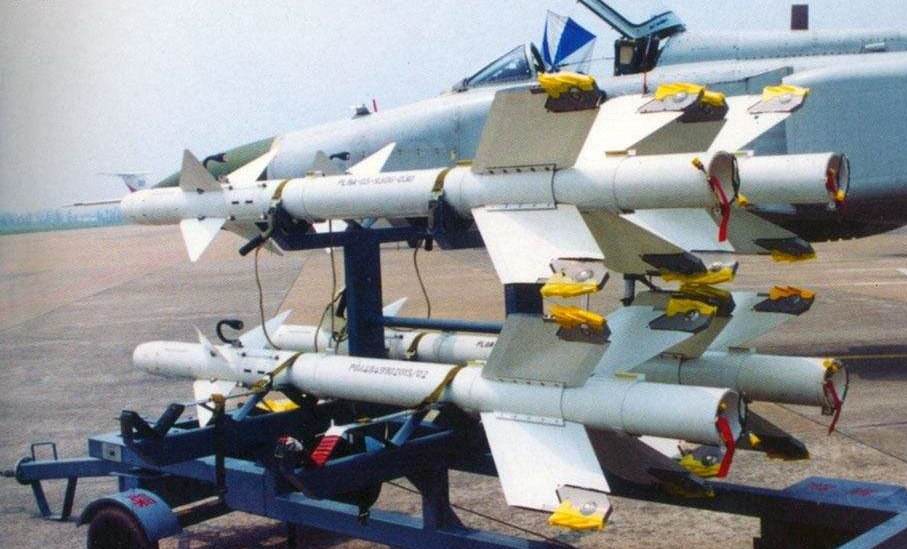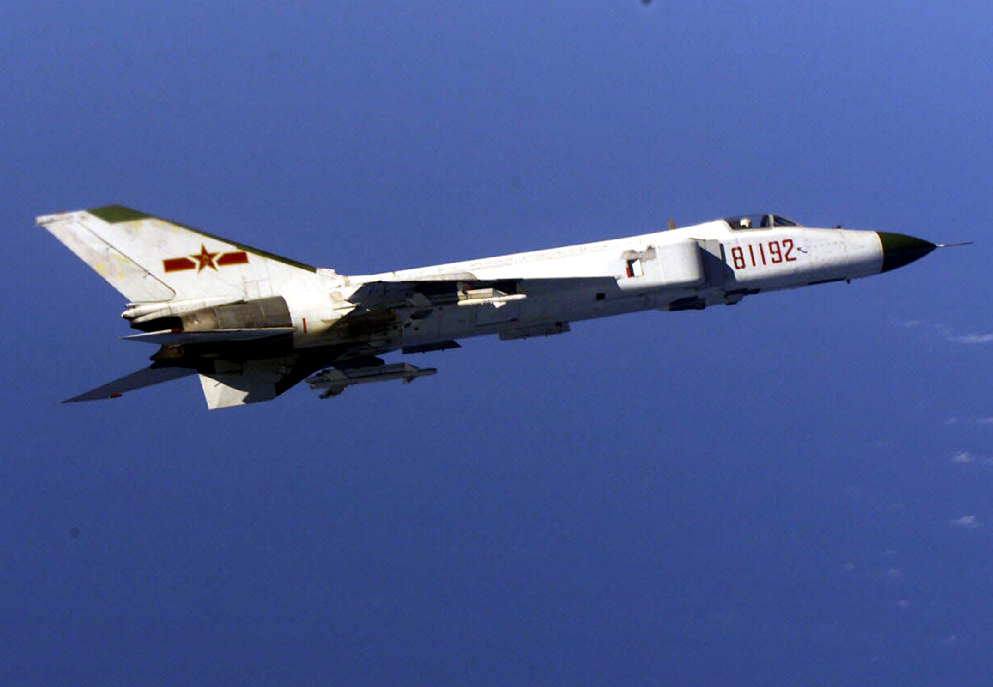| PL-8 air-to-air missile
中国PL-8空对空导弹 Date:2020-11-20 Source:wikia By:Globalmil Viewed: |

The PL-8 is a Chinese air-to-air missile (AAM) originated from the Israeli Python-3 AAM, (PL short for Pili (Pi Li, 霹雳), meaning thunderbolt). Experience gained from PL-8/Python-3 had helped China greatly in developing its next missile, the PL-9.
PL-8是中国的一种空对空导弹(AAM),起源于以色列的“怪蛇”(Python)-3 AAM(Pili是霹雳(Pi Li,霹雳)的缩写,意为霹雳)。 从PL-8/ Python-3获得的经验极大地帮助了中国开发其下一代导弹PL-9。
China's PLAAF was quite impressed with this missile, and paid for licensed production as the PL-8 AAM in the 1980s. The program was code named "Number 8 Project" (八号工程) and formally started on September 15, 1983. The major supplier of the missile was Xi'an Eastern Machinery Factory (西安东方机械厂) located in Xi'an. From March 1988 to April 1989, technology transfer to China was complete while license assembly and license built parts continued, and by the spring of 1989, the complete domestic Chinese built missile received state certification.
中国人民解放军对这种导弹印象深刻,并在20世纪80年代支付了生产PL-8 AAM的许可证,该项目代号为“8号工程”,并于1983年9月15日正式启动。导弹的主要供应商是位于西安的西安东方机械厂。从1988年3月到1989年4月,完成了对中国的技术转让,许可装配和许可制造部件继续进行,到1989年春,中国制造的完整导弹获得了国家认证。
China has also developed a helmet-mounted sight (HMS) system for the PL-8. Elbit Systems DASH (Display And Sight Helmet) helmet mounted sight (HMS). However, it’s not clear that if this was part of the Python-3 deal or a separate deal instead.
中国还为PL-8开发了头盔瞄准具(HMS)系统。以色列埃尔比特系统(Elbit Systems)公司DASH(显示和瞄准头盔)头盔式瞄准具(HMS)。但是,目前尚不清楚这是Python-3协议的一部分还是单独的协议。
The seeker of the original Python-3 AAM was able to be slaved to either the airborne fire control radars or DASH HMS. These capabilities initially did not exist on PL-8 at the earlier stage of its service in Chinese hands, because the missile is only compatible with western radars, but not compatible with Chinese radars. The only exception was that capability of being slaved to airborne fire control radars could be achieved by PL-8 only when it is used in conjunction with the few western radars in Chinese inventory, such as the British GEC-Marconi Skyranger airborne radar and Italian FIAR Grifo series airborne radar on Chengdu J-7, but for most part, the seeker of PL-8 could only be fixed, pointing to the front when deployed on aircraft with domestic Chinese radars. These capabilities would not be fully achieved until the advent of PL-9, the next Chinese AAM, when the missile became compatible not only with western radars, but also Chinese and Russian radars as well, and these capabilities of PL-9 were eventually incorporated to PL-8 AAMs in its upgrades so that PL-8 is fully capable as Python-3.
最初的Python-3空对空导弹的导引头能够被机载火控雷达或DASH HMS所控制。这些能力最初在PL-8服役初期并不存在于中国人手中,因为该导弹仅与西方雷达兼容,而与中国雷达不兼容。唯一的例外是,只有与中国库存中的少数西方雷达配合使用时,例如英国GEC-Marconi Skyranger机载雷达和成都J-7上的意大利FIAR Grifo系列机载雷达,才能实现从机载火控雷达中获得控制PL-8能力,但是在大多数情况下,PL-8的导引头只能固定,当部署在装有中国国产雷达的飞机上时指向前方。直到下一代中国空对空导弹PL-9出现时,这些能力才能完全实现,当时该导弹不仅与西方雷达兼容,而且也与中国和俄罗斯雷达兼容,并且最终合并了PL-9的这些功能升级到PL-8空对空导弹上,以便PL-8完全具备Python-3的功能。
Versions
型号
在中国海军沈阳J-8拦截机上清楚地发现了两枚PL-8空对空导弹
Unlike the conventional Chinese designation practice where a missile is given a Chinese name after at least 70% of it is made in China, Python 3 received a Chinese name at the very beginning, receiving PL-8 when it was purchased. It was speculated that China did so because it did not want to further reveal its tie with Israel, so that the original Israeli name was replaced with a Chinese one to avoid harming the relationship between Chinese and Muslim countries.
与传统的中文命名惯例不同,在中国至少有70%的导弹是在中国制造后才给中文命名的,而Python 3在一开始就获得了中文命名,在购买时便获得PL-8。据推测,中国之所以这样做,是因为它不想进一步透露与以色列的关系,因此将以色列原命名改为中文,以避免损害中国与穆斯林国家之间的关系。
As PL-8/Python 3 AAM has wing span much larger than PL-2/PL-5 (which has dimensions close to AIM-9 missiles), Chinese fighter jets were modified to carry extended pylon to carry PL-8 missiles. Wingtip pylon of newly released J-15 carrier based fighter jet is also extended for this purpose, and become a visual signature of J-15 comparing Su-33.
由于PL-8/Python 3空对空导弹的翼展比PL-2/PL-5(其尺寸接近AIM-9导弹)大得多,因此中国战斗机进行了改装,可以携带扩展的挂架来携带PL-8导弹。为此,新发布的基于J-15航母的战斗机的翼尖挂架也得到了扩展,并成为J-15与Su-33相比的一个视觉标志。
PL-8: Python 3 AAM provided by Israel
PL-8A: License assembled AAM in China with Israeli supplied components
PL-8B: Chinese built AAM with 100% domestic Chinese components
PL-8H: Surface-to-air version with slightly smaller warhead weighing 10 kg
The surface-to-air version is developed by China National Aero-Technology Import & Export Corporation (CATIC). According to the developers, there are minor improvements incorporated in each version, but they have not specified the exact upgrades.
PL-8:Python 3空对空导弹 由以色列提供
PL-8A:在中国使用以色列供应的部件组装的空对空导弹
PL-8B:中国制造的空对空导弹,100%采用中国国产部件
PL-8H:地对空版本,弹头稍小,重10公斤
地对空版本是由中国航空技术进出口公司(CATIC)开发的。据开发人员说,每个版本都有一些小的改进,但他们没有详细说明具体的升级。
PL-8
Type air-to-air missile and Surface-to-air missile
Place of origin China
Service history
In service 1988 to present
Used by China
Production history
Manufacturer Xi'an Eastern Machinery Factory and CATIC
Produced 1988 to 1990’s
Specifications
Weight 115 kg
Length 2.95 meter
Diameter 160 mm
Warhead 11 kg high explosive
Detonation
mechanism Impact / Proximity
Engine solid rocket
Wingspan 800 mm
Propellant solid fuel
Operational
range 20 km
Flight ceiling 21 km
Flight altitude 0.5 km minimum
Speed ≈ Mach 3.5
Guidance
system passive infrared homing
Launch
platform aerial and ground
PL-8
类型 空空导弹和地空导弹
原产地 中国
服役历史记录
1988年至今在役
中国使用
生产历史
生产厂家 西安东方机械厂、中航工业
1988年至1990年生产
规格
重量 115公斤
长度 2.95米
直径 160毫米
弹头 11公斤高爆药
起爆
碰撞/接近
发动机 固体火箭
翼展 800毫米
推进剂 固体燃料
可操作
射程 20公里
飞行高度 21公里
飞行高度 最低0.5公里
速度 ≈马赫3.5
制导
被动红外寻的系统
发射
空中平台和地面
上一篇:PL-7 air-to-air missile 下一篇:PL-9 air-to-air missile
| PL-20/PL-21 active radar-guided ultra-long-range air-to-air missile
综述:中国PL-20/PL-21型主动雷达制导超远程空对空导弹 |
| The PL-21 (Thunderbolt-21) missile is considered to be an active radar-guided ultra-long-range air -to - air missile independently developed by China .... [2022-04-24] |
| PL-15/Pili-15 Air-to-Air Missile
综述:PL-15/"霹雳-15型“(Pili-15)空对空导弹 |
| The Pili-15 was developed by the China Air-to-Air Missile Research Institute. ... [2022-02-15] |
| PL-15 air-to-air missile
PL-15空空导弹 |
| The PL-15 (Chinese: 霹雳-15; pinyin: Pī Lì-15; literally: "Thunderbolt-15") is an active radar-guided very long range air-to-air missile developed by the People's Republic of China.... [2022-02-05] |
| PL-14 Air-to-Air Missile
中国PL-14空空导弹 |
| The PL-14 is a very poorly attested designator that is only mentioned in passing in a few Chinese sources. ... [2022-02-03] |

